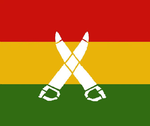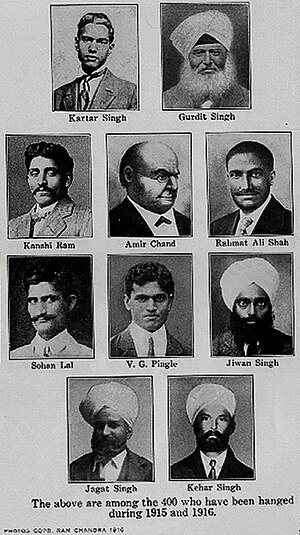Ghadar Movement
Ghadar Party | |
|---|---|
 | |
| President | Sohan Singh Bhakna |
| Founded | 15 July 1913 |
| Dissolved | January 1948 |
| Ideology | Indian independence Indian nationalism Communism[1] |
| Colours | Red, saffron, green |
The Ghadar Movement or Ghadar Party was an early 20th-century, international political movement founded by expatriate Indians to overthrow British rule in India.[2]
Following the outbreak of World War I in 1914, some Ghadar Party members returned to the Punjab to incite armed revolution for Indian independence. Ghadarites smuggled arms into India and incited Indian troops to mutiny against the British. This uprising, known as the Ghadar Mutiny, was unsuccessful, and 42 mutineers were executed following the Lahore Conspiracy Case trial. From 1914 to 1917, Ghadarites continued underground anti-colonial actions with the support of Germany and Ottoman Turkey, known as the Hindu–German Conspiracy, which led to a sensational trial in San Francisco in 1917.
Following the war's conclusion, the party in the United States fractured into a communist and an Indian socialist faction. The party was formally dissolved in 1948.[2] Key participants in the Ghadar Movement included K. B. Menon, Sohan Singh Bhakna, Mewa Singh Lopoke, Kesar Singh, Baba Jawala Singh, Balwant Singh, Santokh Singh, Bhai Parmanand, Vishnu Ganesh Pingle, Bhagwan Singh Gyanee, Har Dayal, Tarak Nath Das, Bhagat Singh Thind, Kartar Singh Sarabha, Udham Singh, Abdul Hafiz Mohamed Barakatullah, Rai Nawab Khan, Rashbehari Bose, and Gulab Kaur. Although its attempts at overthrowing the British Raj were unsuccessful, the insurrectionary ideals of the Ghadar Party influenced members of the Indian independence movement opposed to Gandhian nonviolence.
Etymology
Ghadar is a Punjabi and Urdu word derived from Arabic which means "revolt" or "rebellion".[3] It is often also spelled Ghadr or Gadar in English. The movement's name was closely associated with its newspaper, the Hindustan Ghadar.
Background

Between 1903 and 1913, approximately 10,000 South Asians emigres entered North America, mostly from the rural regions of central Punjab.[4][5] About half the Punjabis had served in the British military. The Canadian government decided to curtail this influx with a series of laws, which were aimed at limiting the entry of South Asians into the country and restricting the political rights of those already in the country.[6] Many migrants came to work in the fields, factories, and logging camps of Northern California and the Pacific Northwest, where they were exposed to labor unions and the ideas of the radical Industrial Workers of the World or IWW. The migrants of the Pacific Northwest banded together in Sikh gurdwaras and formed political Hindustani Associations for mutual aid.

Nationalist sentiments were also building around the world among South Asian emigres and students, where they could organize more freely than in British India. Several dozen students came to study at the University of Berkeley, some spurred by a scholarship offered by a wealthy Punjabi farmer. Revolutionary intellectuals like Har Dayal and Taraknath Das attempted to organize students and educate them in anarchist and nationalist ideas.
Rash Behari Bose on request from Vishnu Ganesh Pingle, an American trained Ghadar, who met Bose at Benares and requested him to take up the leadership of the coming revolution. But before accepting the responsibility, he sent Sachin Sanyal to the Punjab to assess the situation. Sachin returned very optimistic,[2][7] in the United States and Canada with the aim to liberate India from British rule. The movement began with a group of immigrants known as the Hindustani Workers of the Pacific Coast.[2]
The Ghadar Party, initially the Pacific Coast Hindustan Association, was formed on 15 July 1913 in the United States but before a decision to create headquarter at Yugantar Ashram in San Francisco was taken at a meeting in the town of Astoria in the US state of Oregon under the leadership of Har Dayal, Sant Baba Wasakha Singh Dadehar, Baba Jawala Singh, Santokh Singh, and Sohan Singh Bhakna[8] as its president. The members of the party were Indian immigrants, largely from the Punjab.[6] Many of its members were students at University of California at Berkeley including Dayal, Tarak Nath Das, Maulavi Barkatullah, Harnam Singh Tundilat, Kartar Singh Sarabha, and V. G. Pingle. The party quickly gained support from Indian expatriates, especially in the United States, Canada, East Africa, and Asia.
Newspaper

The party was built around the weekly paper The Ghadar, which carried the caption on the masthead: Angrezi Raj Ka Dushman (an enemy of the British rule). "Wanted brave soldiers", the Ghadar declared, "to stir up rebellion in India. Pay-death; Price-martyrdom; Pension-liberty; Field of battle-India". The ideology of the party was strongly secular. In the words of Sohan Singh Bhakna, who later became a major peasant leader of Punjab: "We were not Sikhs or Punjabis. Our religion was patriotism". The first issue of The Ghadar, was published in San Francisco on 1 November 1913.

As Kartar Singh Sarabha, one of the founders of the party, wrote in the first issue: "Today there begins 'Ghadar' in foreign lands, but in our country's tongue, a war against the British Raj. What is our name? Ghadar. What is our work? Ghadar. Where will be the Revolution? In India. The time will soon come when rifles and blood will take the place of pens and ink."
Following the voyage of the Komagata Maru in 1914, a direct challenge to Canadian anti-Indian immigration laws, several thousand Indians resident in the United States sold their business and homes ready to drive the British from India. However, Har Dayal had fled to Europe concerned that the US authorities would hand him over to the British. Sohan Singh Bhakna was already in British hands, and the leadership fell to Ram Chandra. Following the entry of Canada into World War I, the organisation was centred in the US and received substantial funding from the German government. They had a very militant tone, as illustrated by this quote from Harnam Singh:
- No pundits or mullahs do we need
The party rose to prominence in the second decade of the 20th century, and grew in strength owing to Indian discontent over World War I and the lack of political reforms.[citation needed]
In 1914, Kasi Ram Joshi a member of the party from Haryana, returned to India from America. On 15 March 1915, he was hanged by the colonial government.[9]
In 1917, some of their leaders were arrested and put on trial in the Hindu–German Conspiracy Trial in which their paper was quoted.[citation needed]
The Ghadar Party commanded a loyal following the province of the Punjab, but many of its most prominent activists were forced into exile to Canada and the United States. It ceased to play an active role in Indian politics after.[citation needed]
Although publications about an independent Hindustan and revolutionary activities of the Ghadar Party against British rule continued from 5 Wood Street San Francisco, where the Ghadar Memorial has been built, Har Dayal (one among its founding members) severed all connections with revolutionists. He penned an open letter published in March 1919 by Indian newspapers and the New Statesman, and by wrote to the British government for obtaining amnesty for himself.[10]
The party had active members in other countries such as Mexico, Japan, China, Singapore, Siam, the Philippines, Malaya, Indochina, and East Africa and Southern Africa.
Founding members
- Sohan Singh Bhakna (President)
- Bhagwan Singh Gyanee (President, 1914)
- Kesar Singh (Vice-President)
- Baba Jawala Singh (Vice-President)
- Kartar Singh Sarabha (Editor, Punjabi Gadar)
- Pt. Kanshi Ram (Treasurer)
- Munshi Ram (Organizing Secretary)
- Lala Thakur Das Dhuri (Vice Secretary)
- Lala Hardayal (General Secretary & Editor, Urdu Gadar)
- Udham Singh
- Bhai Parmanand
- Tarak Nath Das
- V. G. Pingle
- Santokh Singh
- Balwant Singh
- Rehmat Ali
- Harnam Singh Tundilat
- G. D. Verma
- Nidhan Singh Chugha
- Chattar Singh Jethuwal
- Baba Harnam Singh (Kari Sari)
- Mangu Ram Mugowalia[11][12]
- Amir Chand
- Wasakha Singh
- Maulavi Barkatullah
- Harnam Singh Saini
- Pandurang Sadashiv Khankhoje
- Ganda Singh Phangureh
- Karim Bux
- Baba Prithvi Singh Azad
- Gulab Kaur
- Pt. Ram Rakha
- Sohanlal Pathak
See also
References
- Notes
- ^ Template:Https://archive.org/stream/in.ernet.dli.2015.460856/2015.460856.The-Role djvu.txt
- ^ 2.0 2.1 2.2 2.3 "Ghadr (Sikh political organization)". Encyclopædia Britannica. Archived from the original on 10 November 2010. Retrieved 18 September 2010.
- ^ Ramnath 2011, p. 2.
- ^ Puri, Harish K. (1993). Ghadar Movement: ideology, organisation, and strategy (2nd ed.). Amritsar: Guru Nanak Dev University. pp. 17–18. Archived from the original on 27 July 2021. Retrieved 14 May 2020.
- ^ Ramnath 2011, p. 17.
- ^ 6.0 6.1 Strachan 2001, p. 795
- ^ "Rash Behari Bose : The Greatest Indian Revolutionary". Hindu Janajagruti Samiti. 6 July 2017. Archived from the original on 10 February 2021. Retrieved 17 April 2019.
- ^ Law, Steve (19 September 2013). "Oregon marks ties with India revolutionaries". Portland Tribune. Archived from the original on 29 March 2019. Retrieved 29 March 2019.
- ^ Haryana Samvad Archived 2018-08-27 at the Wayback Machine, Jan 2018.
- ^ Brown, Emily C. (1975). Har Dayal: Hindu Revolutionary and Rationalist. Arizona University Press. p. 222.
- ^ "Manguram Muggowal, a former Ghadar Party member, later joined the Dalit [the proper term for so-called untouchables] emancipation movement". Georgia Straight Vancouver's News & Entertainment Weekly. 26 July 2013. Archived from the original on 4 March 2016. Retrieved 7 October 2015.
- ^ "REMARKABLE MISSION OF BABU MANGOO RAM MUGOWALIA". www.ambedkartimes.com. Archived from the original on 22 August 2014. Retrieved 24 July 2014.
There were not many Scheduled Caste persons in the Ghadar movement, however; Mangoo Ram recalls only one other Chamar besides himself.
[self-published source?]
- Sources
- Strachan, Hew (2001). The First World War: Volume I: To Arms. Oxford University Press. ISBN 0-19-926191-1.
- Ramnath, Maia (2011). Haj to Utopia: How the Ghadar Movement Charted Global Radicalism and Attempted to Overthrow the British Empire. University of California Press. ISBN 978-0-520-95039-9. Project MUSE book 26045.
Further reading
- Singh, Gajendra (November 2019). "Jodh Singh, The Ghadar Movement and the Anti-Colonial Deviant in the Anglo-American Imagination". Past & Present (245): 187–219. doi:10.1093/pastj/gtz023. hdl:10871/37620.
- Ajmer Singh - Gadari Babe Kaun San -https://archive.org/details/GadriBabeKounSanByAjmerSingh
- Gill, M. S. (2007). Trials that Changed History: From Socrates to Saddam Hussein. New Delhi: Sarup & Sons. pp. 92–99. ISBN 978-81-7625-797-8.
External links
- A Gallery on Gadar Party
- Ghadar Party materials in the South Asian American Digital Archive (SAADA)
- [ http://www.collectionscanada.ca/obj/s4/f2/dsk2/tape17/PQDD_0001/MQ36004.pdf Ghadar: The Indian Immigrant Outrage Against Canadian Injustices 1900 - 1918] by Sukhdeep Bhoi
- The Hindustan Ghadar Collection. The Bancroft Library, University of California, Berkeley
- Communist Ghadar Party of India
- Webarchive template wayback links
- Articles with self-published sources from November 2023
- Short description with empty Wikidata description
- Articles with unsourced statements from July 2020
- Articles with invalid date parameter in template
- Commons category link is the pagename
- Hindu–German Conspiracy
- Ghadar Party
- Indian-American history
- Revolutionary movement for Indian independence
- South Asian American organizations
- Sikhism in the United States
- Political parties established in 1913
- Political parties disestablished in 1919
- 1913 establishments in the United States
- Defunct political parties in the United States
- Indian nationalist political parties
